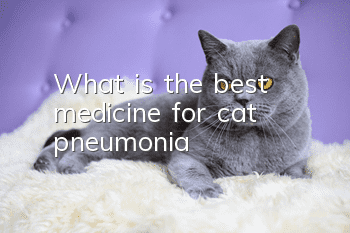What is the best medicine for cat pneumonia?

The weather is getting colder, and cats at home are very susceptible to colds at this time. If not treated in time, they will develop into pneumonia. Pneumonia is an inflammation of the lungs and airways, which can cause difficulty in breathing and blood hypoxia in cats.
The most common causes of cat pneumonia
Feline calicivirus can cause damage to the respiratory tract, making animals susceptible to pneumonia. Infections with bacteria (such as Mycoplasma and Chlamydia) and protozoa (such as Toxoplasma gondii) can also cause pneumonia. Parasites (such as lungworms and flukes) can invade the bronchial tubes and cause pneumonia. Cats can also develop fungal pneumonia. Damage to the bronchial mucosa and inhaled irritants can directly cause pneumonia and predispose animals to bacterial infections. Aspiration pneumonia can be caused by persistent vomiting, force-feeding, or improper medication. It may also occur after breastfeeding in a newborn with a cleft palate.
CatsSymptoms of pneumonia
Pneumonia can be localized to a small area in the lungs or it can spread throughout the body.
Depending on the severity of pneumonia, clinical symptoms can range from mild to severe, including the following:
Difficulty breathing (hard work) or rapid and loud breathing sounds Nostril secretions Drowsiness (fatigue, discomfort) Reduced appetite Fever Cough.
Because multiple microorganisms can cause pneumonia, additional clinical symptoms may be related to the pathogen. For example, the FIP virus can cause pneumonia, but other clinical symptoms may include vomiting, diarrhea, or other complications.
CatPneumoniaDiagnosis
1. Obtaining a medical history and performing a physical examination are the first steps in diagnosing pneumonia. When examining a cat, it is necessary to listen to the cat's chest with a stethoscope for severe breath sounds. This determines whether the air sounds in the lungs and airways are normal and whether there are any audible heart abnormalities.
In addition, it is also necessary to conduct necessary hematology tests, such as biochemistry, blood routine, etc.
Second, use the results of chest radiography (x-ray) to help diagnose pneumonia. Once pneumonia is diagnosed, additional testing (e.g., pathogen testing) may be recommended to help identify the causative organism and investigate possible underlying causes. This is necessary if an infectious cause can be determined. , so that targeted treatment can be carried out and treatment can be carried out quickly so that the animal can recover.
CatsTreatment of pneumonia
Pneumonia can be treated in most cases. However, the prognosis for cats with pneumonia depends largely onon the cause of pneumonia and the overall health of your pet. If the cat is very young, very old, or already suffering from other medical conditions, the prognosis may not be as good as if the patient was healthy before the onset of pneumonia. Additionally, if the underlying cause of pneumonia is the FIP virus or another potentially fatal disease, the patient may recover from the pneumonia but die from other complications of the underlying disease.
CatPneumoniaTreatment goals:
First, stabilize your pet’s physical signs: If your pet has significant difficulty breathing or is otherwise unstable, oxygen therapy and other treatments may be necessary to stabilize the pet.
Secondly, the treatment of pneumonia: mainly from two aspects, on the one hand, symptomatic treatment of lung inflammation to relieve respiratory symptoms; on the other hand, treatment of the cause based on the etiology, antibiotics are often used to treat bacterial infections, if there is Viral infections require antiviral treatment. If a pet has severe pneumonia, it may require hospitalization so that the pet can be observed and physically monitored in real time during treatment.
To deal with any underlying illness: If the specific bacteria, virus, or fungus cannot be identified, additional medications may be prescribed to deal with the infection. Periodic repeat chest X-rays may also be recommended to monitor the resolution of the pneumonia.
CatPneumoniaPrevention
Pneumonia can only be prevented by preventing infectious diseases through routine vaccination and regular physical examinations. Early treatment of any respiratory illness may prevent severe pneumonia.
There are also types of pneumonia:
Aspiration pneumonia is a lung infection caused by inhaling foreign bodies.
The severity of inflammation depends on the substance inhaled, the type of bacteria inhaled, and the distribution of the foreign material in the lungs. A common cause of aspiration pneumonia is improper use of liquid medications. Animals that inhale vomit or partially choke while trying to eat or drink are also at risk for aspiration pneumonia. Animals with laryngeal or esophageal disease and animals weakened by other illnesses are at increased risk for aspiration pneumonia. Disturbance of normal swallowing mechanisms, such as in anesthetized or comatose animals, or animals with deformities such as cleft palate, may also lead to aspiration pneumonia. Cats are particularly susceptible to aspiration pneumonia from inhaling odorless products such as mineral oil.
The bacterium Chlamydia has been identified as a cause of pneumonia in cats.
This type of pneumonia in cats is often associated with the more common chlamydial conjunctivitis and rhinitis. Chlamydial pneumonia is caused by the bacterium Chlamydia. Treatment is with appropriate antibiotics.
Fungal pneumonia (also known as fungal pneumonia) is a fungal infection of the lungs that can lead to pneumoniadevelopment of.
A number of fungi have been shown to cause fungal pneumonia in livestock (see list below). These fungi are usually found in animals with compromised immune systems, but they can also cause disease in healthy animals. The source of most fungal infections is thought to be the inhalation of spores in the soil.
In cats, the fungus Cryptococcus tends to colonize the nasal cavity, where it can cause inflammation of the lining of the nasal cavity and sinuses. Sneezing discharges thick mucus from the nose, and there may be swelling in the upper part of the nose.
Animals with fungal pneumonia often have short, frequent coughs. As the disease progresses, breathing becomes difficult, weight loss occurs, and general weakness occurs. Inflamed lymph nodes can cause pressure on the airways, making it more difficult for your cat to breathe. Periodic fevers may occur, possibly caused by bacterial infections. Depending on the fungus, symptoms may also be seen in other parts of the body, such as the skin, nervous system, bones, digestive tract, or eyes.
- What are the benefits to cats of eating acidified food?
- Can cats drink light salt water if they have heatstroke?
- Why did a Ragdoll cat have diarrhea after eating canned food? What caused it?
- Why cats like to drink milk
- Will British shorthair cats become dependent on probiotics if they often eat them? A must-read for pet owners!
- How to treat nasal branch in Balinese cats
- What should a novice prepare for raising a cat for the first time?
- Misunderstandings about deworming | How to correctly deworm parasites on cats?
- What to do if there is poop on the cat’s anus
- Why do Cornish Rex cats need to be neutered?



